Tools Required
| • | J 44725 Gear
Pack Assembly Fixture |
| • | J 44749 Split
Plate Bearing/Gear Puller |
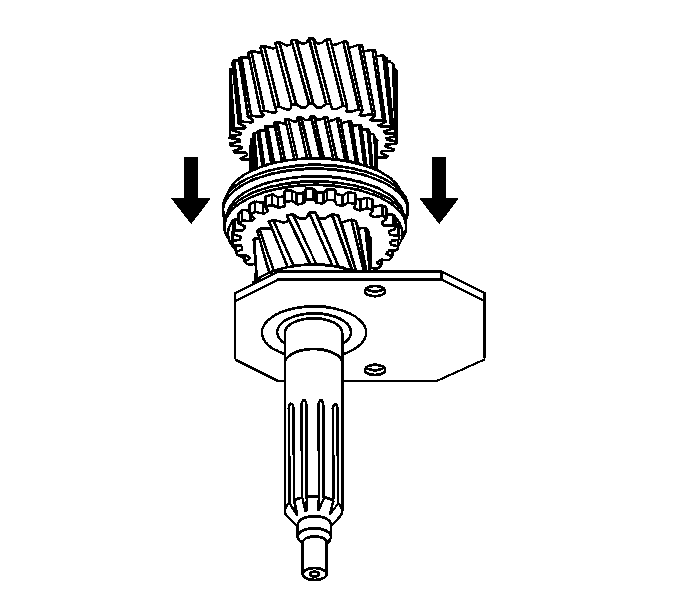
Important: The input shaft is not secured to the mainshaft assembly. In order to
prevent the loss of synchronizer springs and pressure pieces, shift the 4th/5th
synchronizer sleeve to 5th gear before removing from the J 44725
. Moving the synchronizer in 5th gear
will lock the input shaft with the mainshaft.
- Shift the 4th/5th synchronizer hub into 5th gear position.
- While supporting the input shaft, remove the mainshaft assembly
from the J 44725
. Flip
the mainshaft over, and install in the J 44725
with the output end down.

- Shift the 4th/5th synchronizer
sleeve to the neutral position. Ensure the synchronizer sleeve is locked
in the neutral position. Moving the sleeve too far or not enough may
cause the sleeve to jump out of position, and the synchronizer springs
and pressure pieces may be lost.
- Remove the input shaft and set it to the side.

- Install the J 22912-B
(2) under the mainshaft front
bearing. Ensure the J 22912-B
is not pressing against the bearing cage.
- Install the J 8433
(1) to the J 22912-B
(2).
- Remove the mainshaft front bearing.
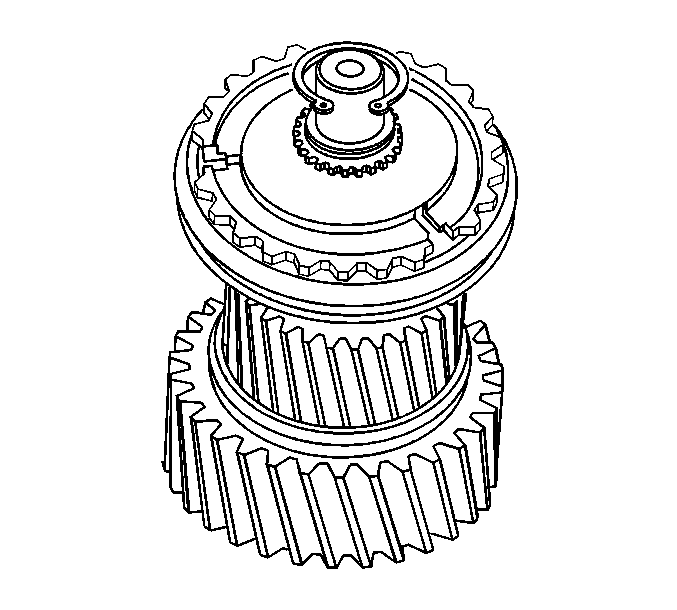
- Remove the retaining ring
for the 4th/5th synchronizer hub and discard.

Important: When you service the synchronizers, retain them in the order that they
are removed. Keep the synchronizer components together and mark to identify
correct location.
- Remove the 5th gear synchronizer blocking ring. Mark the blocking ring
for correct assembly.
- Cover the synchronizer assembly with a shop towel in order to
prevent the loss of springs and pressure pieces.
- Slide the synchronizer sleeve from the synchronizer hub.
- Remove the shop towel with the pressure pieces and springs.
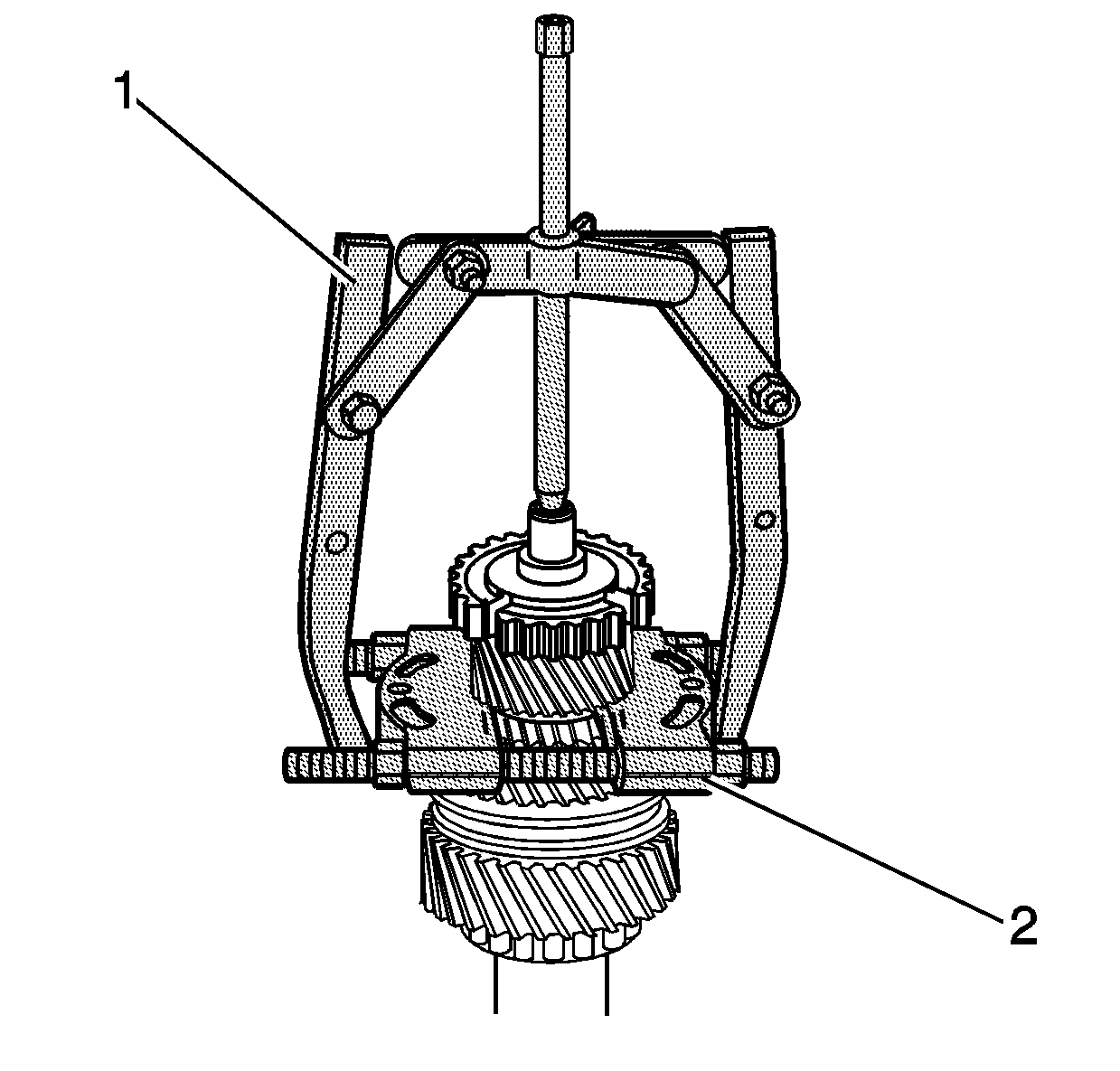
- Remove the 4th/5th synchronizer
hub using the J 44726
(1)
and the J 44749
(2).
| • | Place the J 44749
under the 4th gear. |
| • | Remove the 4th gear and 4th/5th synchronizer hub together. |
- Remove the 4th gear from the 4th/5th synchronizer hub.
- Remove the 4th gear synchronizer blocking ring. Mark the blocking
ring for correct assembly.
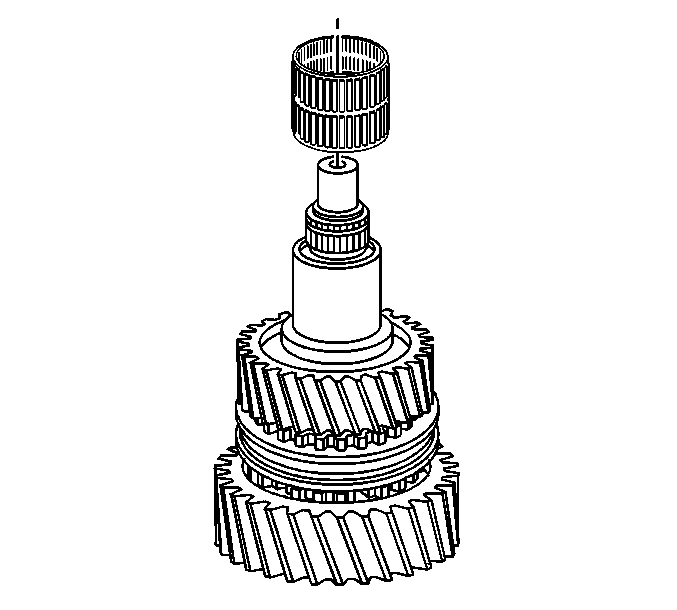
- Remove the 4th gear bearing.
Important: The 3rd gear and 4th gear bearings and bushings are identical parts.
Mark or tag the parts for proper installation. If using the parts again,
install in the same location as they were removed.
- Tag the bearing for correct identification.
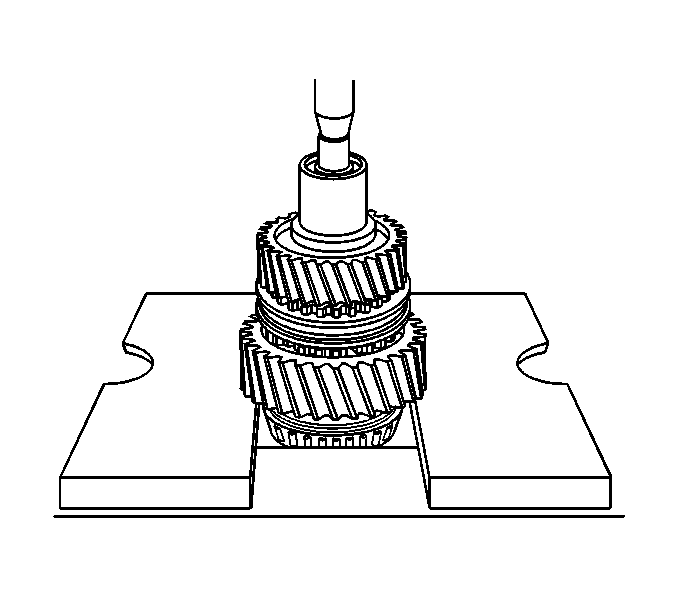
- Use a hydraulic press
to remove the 4th gear bushing, 3rd gear bushing, and 2nd/3rd synchronizer
hub and related parts listed in the next step. Install the press plates
under the 2nd gear.
Depending on the press set up, the pressing
action may have to be stopped to remove the individual parts before pressing
off the next part. If available, a pressing bar about 25 cm (10 in)
long can be used on the end of the mainshaft to press off the parts with
one pressing action. Hold the mainshaft from dropping when the 3rd gear
bushing is coming off the mainshaft.
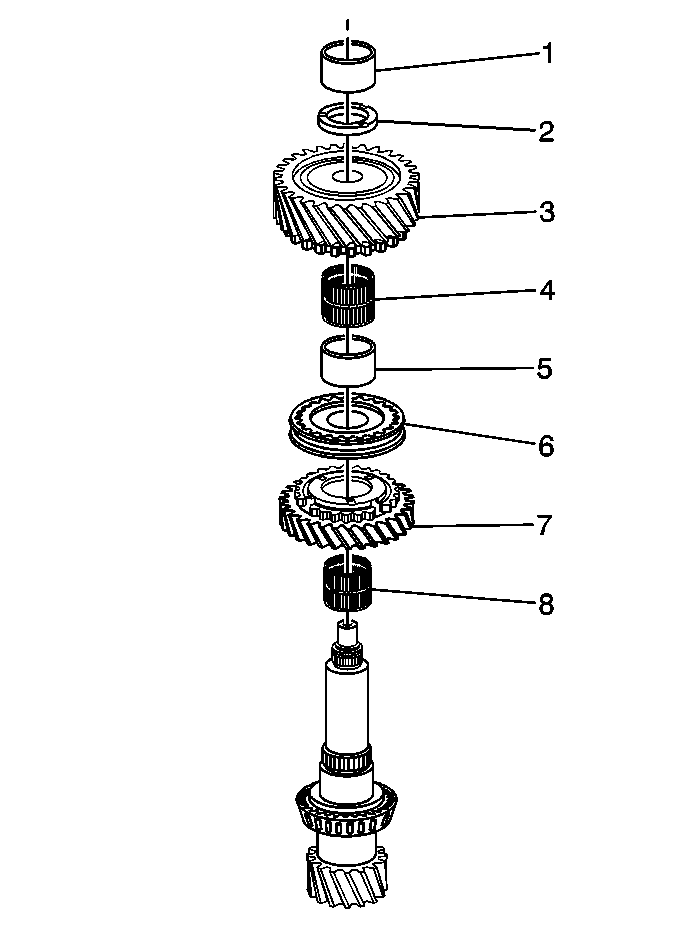
Important: The 3rd gear and 4th gear bearings and bushings are identical parts.
Mark or tag the parts for proper installation. If using the parts again,
install in the same location as they were removed.
- Remove the following components from the mainshaft:
| 19.1. | The 4th gear bushing (1) |
| 19.2. | The thrust washer (2) |
| 19.4. | The 3rd gear bearing (4) |
| 19.5. | The 3rd gear bushing (5) |
| 19.6. | The 2nd/3rd synchronizer assembly (6) |
| 19.8. | The 2nd gear bearing (8) |
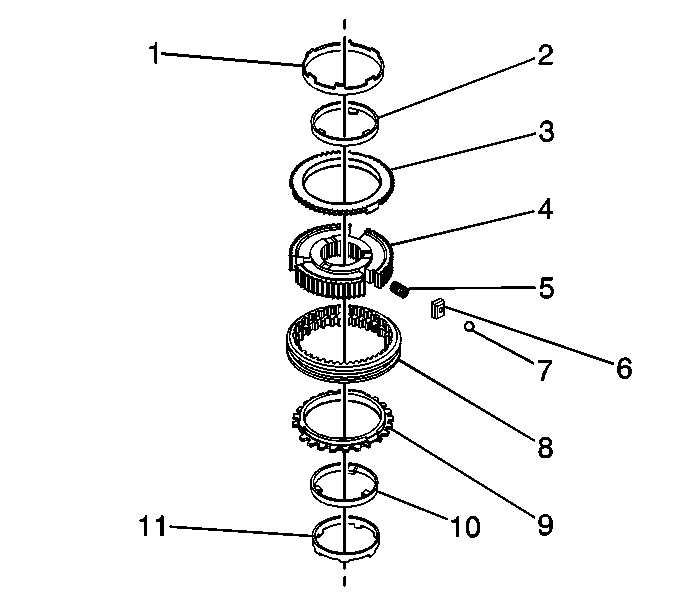
Important: When you service the synchronizers, retain them in the same order as
they were removed. Keep the synchronizer components together and mark to
identify correct location.
- If necessary, disassemble the 2nd/3rd synchronizer assembly.
| 20.1. | Mark the location of the components for proper location during
inspection and assembly. |
| 20.2. | Remove the 3rd gear synchronizer inner ring (1). |
| 20.3. | Remove the 3rd gear synchronizer middle ring (2). |
| 20.4. | Remove the 3rd gear synchronizer blocking ring (3). |
| 20.5. | Cover the synchronizer assembly with a shop towel when removing
the sleeve to prevent loss of the balls, springs and pressure pieces. |
| 20.6. | Remove the 2nd/3rd gear synchronizer sleeve (8) from the
synchronizer hub (4). |
| 20.7. | Remove the 2nd/3rd gear synchronizer detent balls (7),
pressure pieces (6), and springs (5). |
| 20.8. | Remove the 2nd gear synchronizer blocking ring (9). |
| 20.9. | Remove the 2nd gear synchronizer middle ring (10). |
| 20.10. | Remove the 2nd gear synchronizer inner ring (11). |
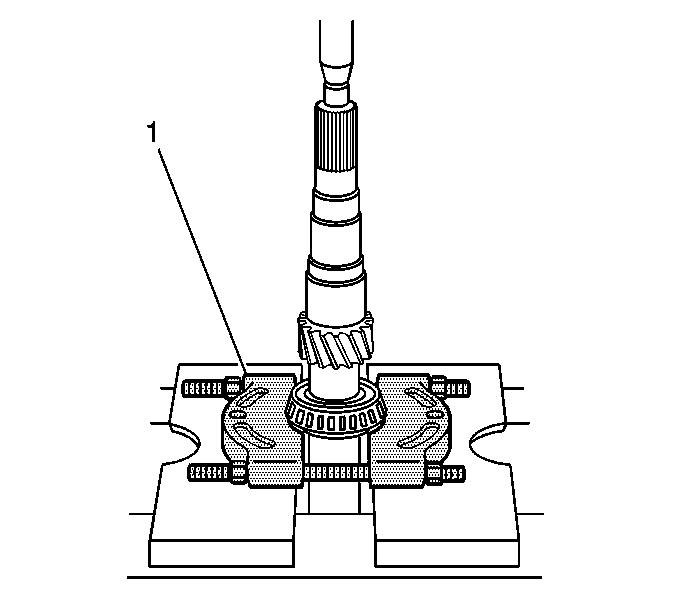
Important:
| • | Only remove the bearings if replacing the bearings. Do not use the
bearings again after removal. |
| • | You must also replace the race for the bearing being replaced. |
- Inspect the mainshaft center bearing. Refer to
Bearings and Spacers Cleaning and Inspection
.
- Using a hydraulic press and the J 44749
(1), remove the mainshaft intermediate case bearing
if necessary.
Tools Required
| • | J 44725 Gear
Pack Assembly Fixture |
| • | J 44749 Split
Plate Bearing Gear Puller |

Important: The input shaft is not secured to the mainshaft assembly. In order to
prevent the loss of synchronizer springs and pressure pieces, shift the
4th/5th synchronizer sleeve to 5th gear before removing from the J 44725
. Moving the synchronizer in 5th gear
will lock the input shaft with the mainshaft.
- Shift the 4th/5th synchronizer hub into 5th gear position.
- While supporting the input shaft, remove the mainshaft assembly
from the J 44725
. Flip
the mainshaft over, and install in the J 44725
with the output end down.

- Shift the 4th/5th synchronizer
sleeve to the neutral position. Ensure the synchronizer sleeve is locked
in the neutral position. Moving the sleeve too far or not enough the sleeve
will jump out of position and the synchronizer springs and pressure pieces
may be lost.
- Remove the input shaft and set to the side.

- Install the J 22912-B
(2) under the mainshaft front
bearing. Ensure the J 22912-B
is not pressing against the bearing cage.
- Install the J 8433
(1) to the J 22912-B
(2).
- Remove the mainshaft front bearing.

- Remove the retaining ring
for the 4th/5th synchronizer hub and discard.

Important: When you service the synchronizers, retain them in the same order as
the components are removed. Keep the synchronizer components together and
mark to identify correct location.
- Remove the 5th gear synchronizer blocking ring. Mark the blocking ring
for correct assembly.
- Cover the synchronizer assembly with a shop towel in order to
prevent the lost of springs and pressure pieces.
- Slide the synchronizer sleeve from the synchronizer hub.
- Remove the shop towel with the pressure pieces and springs.

- Remove the 4th/5th synchronizer
hub using the J 44726
(1)
and the J 44749
(2).
| • | Place the J 44749
under the 4th gear. |
| • | Remove the 4th gear and 4th/5th synchronizer hub together. |
- Remove the 4th gear from the 4th/5th synchronizer hub.
- Remove the 4th gear synchronizer blocking ring. Mark the blocking
ring for correct assembly.

- Remove the 4th gear bearing.
Important: The 3rd gear and 4th gear bearings and bushings are identical parts.
Mark or tag the parts for proper installation. If using the parts again,
install in the same location as removed.
- Tag the bearing for correct identification.

- Use a hydraulic press
to remove the 4th gear bushing, 3rd gear bushing, and the 2nd/3rd synchronizer
hub and the related parts listed in the next step. Install the press plates
under the 2nd gear.
Depending on the press set up, the pressing
action may have to be stopped to remove the individual parts before pressing
off the next part. If available, a pressing bar about 25 cm (10 in)
long can be used on the end of the mainshaft to press off the parts with
one pressing action. Hold the mainshaft from dropping when the 3rd gear bushing
is coming off the mainshaft.

Important: The 3rd gear and 4th gear bearings and bushings are identical parts.
Mark or tag the parts for proper installation. If using the parts again,
install them in the same location as they were removed.
- Remove the following from the mainshaft:
| 19.1. | The 4th gear bushing (1) |
| 19.2. | The thrust washer (2) |
| 19.4. | The 3rd gear bearing (4) |
| 19.5. | The 3rd gear bushing (5) |
| 19.6. | The 2nd/3rd synchronizer assembly (6) |
| 19.8. | The 2nd gear bearing (8) |

Important: When you service the synchronizers, retain them in the same order as
the components are removed. Keep the synchronizer components together
and mark to identify correct location.
- If necessary, disassemble the 2nd/3rd synchronizer assembly.
| 20.1. | Mark the location of the components for proper location during
inspection and assembly. |
| 20.2. | Remove the 3rd gear synchronizer inner ring (1). |
| 20.3. | Remove the 3rd gear synchronizer middle ring (2). |
| 20.4. | Remove the 3rd gear synchronizer blocking ring (3). |
| 20.5. | Cover the synchronizer assembly with a shop towel when removing
the sleeve to prevent lost of the balls, springs and pressure pieces. |
| 20.6. | Remove the 2nd/3rd gear synchronizer sleeve (8) from the
synchronizer hub (4). |
| 20.7. | Remove the 2nd/3rd gear synchronizer detent balls (7),
pressure pieces (6), and springs (5). |
| 20.8. | Remove the 2nd gear synchronizer blocking ring (9). |
| 20.9. | Remove the 2nd gear synchronizer middle ring (10). |
| 20.10. | Remove the 2nd gear synchronizer inner ring (11). |

Important:
| • | Only remove the bearings if you are replacing the bearings. Do not use
the bearings again after removal. |
| • | You must also replace the race for the bearing being replaced. |
- Inspect the mainshaft center bearing. Refer to
Bearings and Spacers Cleaning and Inspection
.
- Using a hydraulic press and the J 44749
(1) remove the mainshaft intermediate case bearing
if necessary.






















